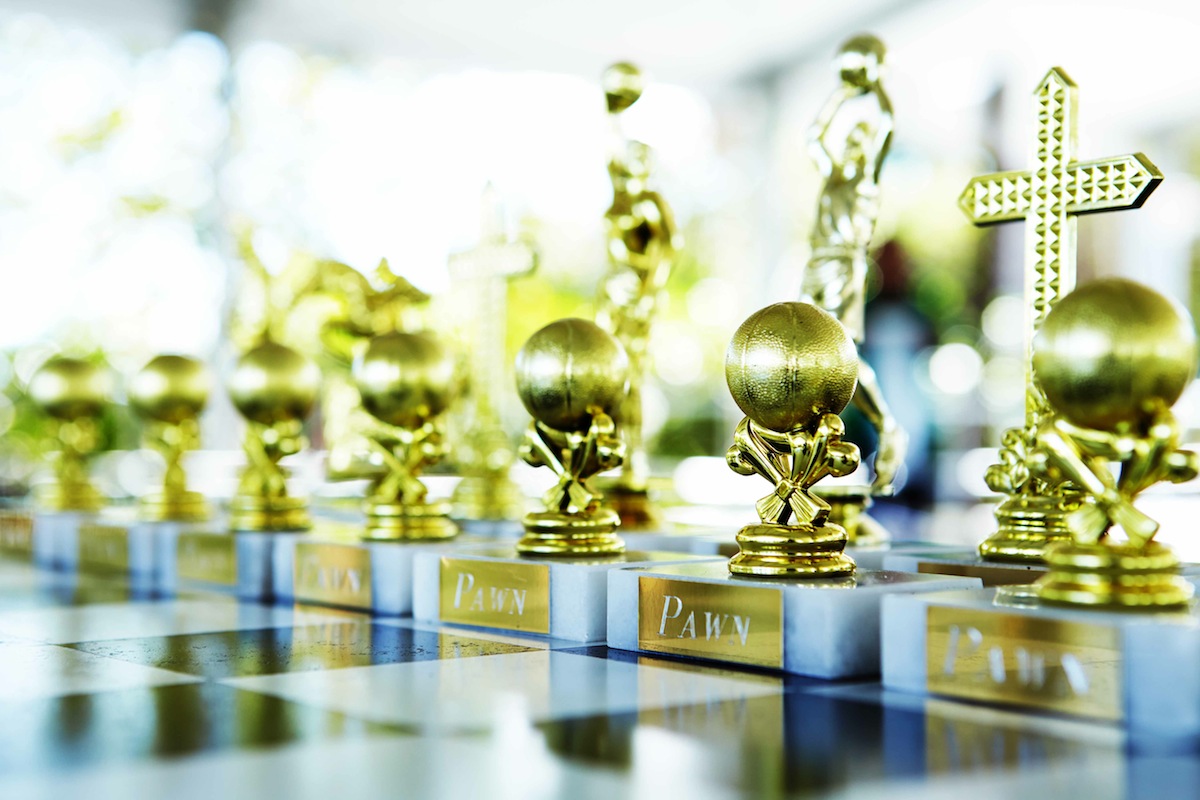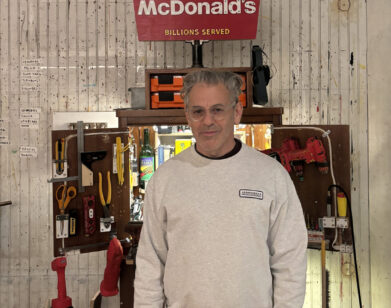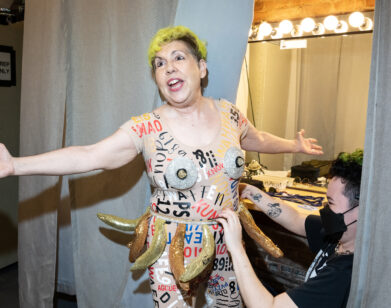Ry Rocklen’s Absolut Sportif
Visitors to this year’s Art Basel Miami Beach will find a temporary watering hole, courtesy of artist Ry Rocklen, that offers food for thought as well as custom cocktails.
Los Angeles-based Rocklen, 35, is known for assemblage sculptures that incorporate found items in a way that draws on the poetic potential of the found material’s past lives. The objects, such as futon mattresses, furniture, and thrift-store paintings, are incorporated into works that frequently exhibit a punning sensibility: a sculpture of a houseplant with leaves made of audio tape is called Trance Plant, for example, and a sculpture with a chair that seems to defy gravity—it’s made of Styrofoam—is called 10,000 Year Wait, punning on “weight.”
A couple of years ago, trophies began to appear in the artist’s works, first in a 2011 piece called Second to None that incorporated trophies found in a thrift store. The symbol of triumph has given birth to a line of functional furniture made of trophy parts and called Trophy Modern. In his ABMB installation, Rocklen has expanded on that idea with a custom designed bar, created in collaboration with the Absolut vodka company, in which trophy furniture appears on a floor that is painted with the markings that typically appear on a basketball court. Night Court also features ping-pong tables, bleachers, chess sets, and a DJ booth, and will host nightly musical performances. All the staff will wear clothes designed by Rocklen.
Rocklen has been included in high-profile group exhibitions on both coasts, including the 2008 Whitney Biennial and the 2012 exhibition “Made in L.A.” He’s also had solo shows at art galleries including L.A.’s Thomas Solomon Gallery and New York’s Untitled.
We met at the bar, situated at the oceanfront near 21st Street, yesterday afternoon.
BRIAN BOUCHER: You started to incorporate trophies in your work a couple of years ago. How did that come about?
RY ROCKLEN: Often, the things I work with are the things that knock me over the head when I see them. As a kid, I had a real fetish for trophies—wanting one for my excellence in basketball. I won one. My team was really good. I didn’t score a basket the whole season, but I was really good on defense.
Then recently I walked into a thrift store one day and there were 150 trophies sitting there, and that’s when it hit me over the head. There was something kind of beautiful and pathetic about them, about what happens when a trophy is given up. There’s a pathos, a sense that something is lost. What is going on, you have to ask, with this unloading of the trophy?
BOUCHER: That’s interesting, because I was thinking that you had gone from working with abject found materials—like in the sculpture Unbrella, which features a shredded umbrella that couldn’t shelter anyone—to ones that speak of triumph, and wondering if that represented a real shift. But it sounds like there’s also a continuity.
ROCKLEN: Right. The trophies don’t appear to be forlorn. They’re still gold and shiny and colorful. But especially with my sculpture Second to None, which incorporates discarded, found trophies, you read all these plaques, and they’re lost heroes, like “Jessica Alvarez, 1989, Little League,” and you wonder, “Where’s baby Jessica now?” To me it recalls Mike Kelley’s work, More Love Hours Than Can Ever Be Repaid. There’s a sense of time spent and dedication to a person or a thing in that piece. I saw that in the trophies too. With Trophy Modern, there’s a lot less pathos. I go through the catalogue and pick out exactly what colors I want.
BOUCHER: You’ve shown Trophy Modern works in galleries and at a fair, but I assume this is the biggest work you’ve done in this style.
ROCKLEN: It’s probably the biggest project I’ve done, and definitely the biggest budget I’ve had to work with.
BOUCHER: What’s that like?
ROCKLEN: It’s nice to know it’s something I’m capable of. This was exciting in that I got to get a lawyer, and I arranged for the shipment of the work. Wielding semis was exciting. Getting insurance and all that weird shit was satisfying in a way, to know that I could do it.
BOUCHER: Do you follow sports or play sports?
ROCKLEN: I love watching sports. I love the aesthetic of sports, the spectacle of the arena and the stadium. I love the perfection you can attain in a game, doing something your absolute best. I love physics, watching masses collide, especially in football, and the arc of a ball traveling through the air. I like the reality TV drama aspect of the players and their lives and their moving from team to team, the drama inside and outside the court.
BOUCHER: Your works often exhibit a love for wordplay. Tell me about the words “Trophy Modern.” I can’t help but think of a— pardon the pun with your name—wry commentary on collectors hunting for trophies at places like art fairs and galleries.
ROCKLEN: People buy and sell trophies all the time here at Art Basel. You’ve made it, and you’re powerful and rich enough to buy expensive trinkets for your home.
BOUCHER: You’ve mentioned that now that you’re using them in your work, people have started giving you their old trophies. What’s that like? Do you hear funny or sad backstories?
ROCKLEN: I always get “I have my kid’s old trophies and I want to get rid of them.” I have a connection to some of the trophies. One of my sister’s old trophies is in Second to None. I actually didn’t put mine in there, which I guess is kind of silly. Some of [my New York dealer] Joel Mesler’s old trophies are in there.
BOUCHER: Tell me about the cocktail menu. What was the process for devising the drinks?
ROCKLEN: I worked with a mixologist on the cocktails. I supplied the names. I wanted to use basketball and sports terms, so we have “The Winning Spirit,” which is a shot of Absolut over ice, and the “And One,” which is, in basketball, when you score a point and get fouled in the process and get a free throw. That’s a cocktail mixed with blueberry and ginger, and a shot of vodka infused with vanilla on the side. And then we have the “Blood of a Champion,” which is not as common a sports term as I thought it was. That’s a Bloody Mary. Then there’s “ModernAde,” which is inspired by sports drinks.
BOUCHER: Who are some of the musical performers you’ve invited, and what kinds of music do they play? Do they fit in with the expressed theme of “competition and success,” or are they simply favorites of yours?
ROCKLEN: It’s both. A lot of them are friends of mine from L.A., because I know a lot of amazingly talented people from there, and it felt good to bring artists a lot of people here haven’t seen before. And I wanted the performers to have an American aspect. Somehow their enterprise is born out of their Americanness, because all this trophy business is so particularly American.
Tonight, Bodies International is performing. They’re an exercise performance group, sort of Jane Fonda-esque, Richard Simmons-esque. They’re almost the house band. Also tonight is Mykki Blanco.
Wednesday is Dynasty Handbag, who has an element of humor and a distinctly American neurotic weirdness. Thursday there’s Nite Jewel, a great pop artist, and performance artist Barry Johnston, who has a similar sensibility to mine. He’s using a kick drum and dirt for this performance. Friday we have TMO Live and my sweetheart, Bouquet. Saturday is my rap group, the Bushes, and Yung Jake.
BOUCHER: Some of your earlier works posited characters, like “the surrenderer” and “the harborer.” Did you have any particular characters in mind to inhabit Night Court?
ROCKLEN: There’s a kind of middle-class aspect to this. That’s become an interest of mine, especially in light of the purge of the middle class in 2008. It’s a classic sensibility. Raise a family, your kids go to Little League, there’s a public recreational aspect to it. I think of institutions that support the AYSO [American Youth Soccer Organization] or Little League. Those kinds of institutions are related to greater public institutions that are being decimated. No matter what class you’re from, kids want to win a trophy. But in my mind there’s a classic American middle class that the trophies are linked to. The character, if there is one, is Joe Schmo, or Jessica Alvarez—and I just pulled that name out of a hat. The barstools are called Victor’s Perch. It’s a classic pun because it’s a particular person named Victor but it’s also just a person who’s victorious.
BOUCHER: Not “the collector” or “the trophy hunter”? Too obvious, I guess.
ROCKLEN: What I strive for with all my pun titles is that they have multiple meanings. Generally I’m not much of a cynic. I’m not super ironic in my work. There’s a sincerity. It’s more about the pathos-ridden place. It started with a sculpture and it’s morphed into a system I can wield to create an entire universe.
RY ROCKLEN’S “NIGHT COURT” IS OPEN ON OCEANFRONT, MIAMI BEACH, TODAY, DECEMBER 4 THROUGH SATURDAY, DECEMBER 7, FROM 12 NOON UNTIL 2 A.M. EACH DAY.
For more of Interview‘s coverage of Art Basel Miami Beach, please click here.







